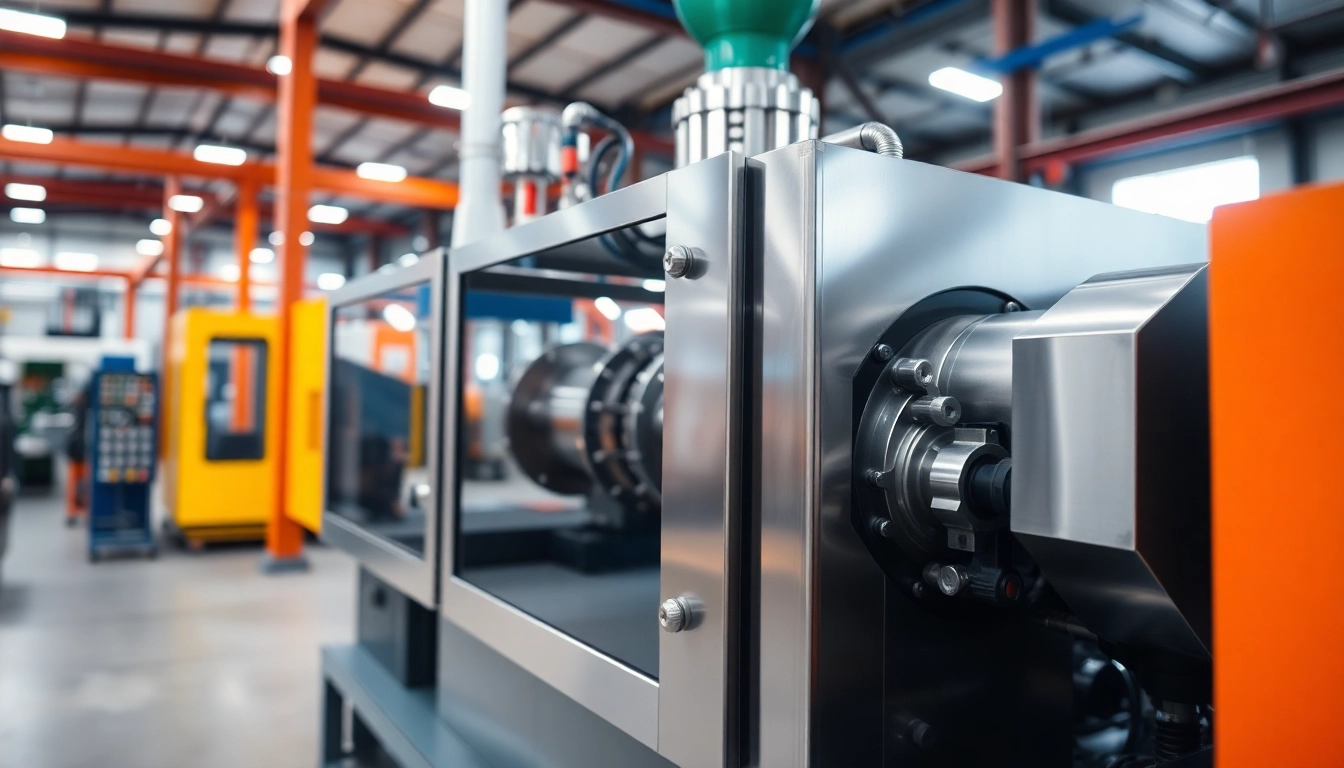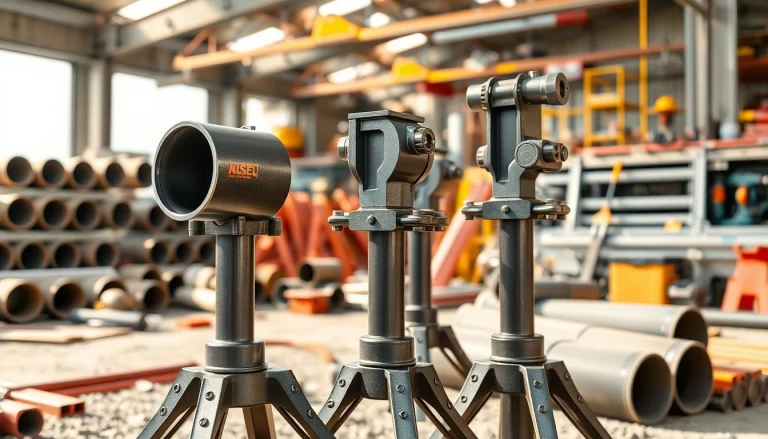Understanding Blow Molding Technology
The Basics of Blow Molding
Blow molding is a manufacturing process primarily used to create hollow plastic parts. This method utilizes air pressure to inflate soft plastic into the desired shape of a mold. The process consists of three main stages: the first is the extruding or molding of a parison, followed by positioning the parison within a mold, and finally, inflating it to fill the mold cavity. This technique is widely used for producing bottles, containers, and various hollow shapes, owing to its speed, efficiency, and cost-effectiveness.
Types of Blow Molding Processes
There are three predominant types of blow molding processes: extrusion blow molding (EBM), injection blow molding (IBM), and stretch blow molding (SBM). Each method offers unique advantages suited for different applications:
- Extrusion Blow Molding (EBM): This process involves extruding a tube of heated plastic (the parison), which is then clamped into a mold and inflated to create the desired shape. EBM is ideal for creating large and complex shapes, such as industrial containers.
- Injection Blow Molding (IBM): In IBM, a preform is first injection molded, and then air is blown into the preform within a mold to shape the final product. This method is often used for smaller items like bottles due to its precision and ability to maintain tight tolerances.
- Stretch Blow Molding (SBM): This is commonly used for producing PET bottles. The process stretches the preform before inflating it, which enhances the strength of the finished product. SBM combines aspects of both EBM and IBM.
Applications of Blow Molding Machines
Blow molding machines are utilized across various industries, producing a wide range of products. Some of the main applications include:
- Beverage Bottles: One of the most common products manufactured using blow molding is plastic bottles for soft drinks, water, and other beverages.
- Household Items: Containers for cleaning products, shampoo bottles, and other household goods are frequently produced through blow molding methods.
- Automotive Components: Parts such as fuel tanks, air ducts, and other hollow plastic components in vehicles often utilize blow molding for production.
- Industrial Containers: Large containers for chemicals or other materials can be produced with blow molding machines to cater to various industries.
Choosing the Right Blow Molding Machine Supplier
Key Factors to Consider
Choosing a supplier for blow molding machines is a critical decision that can impact your manufacturing capabilities. Important factors to consider include:
- Machine Quality: Evaluate the quality and reliability of the machines offered. Research suppliers to understand their manufacturing standards and competition.
- Customization Options: Determine if the supplier can provide machines tailored to meet your specific production needs, as different applications may require distinct configurations.
- Customer Support: Assess the level of ongoing customer support and service options the supplier offers, ensuring they can assist in case of machine issues or malfunctions.
- Technical Expertise: Choose a supplier with a solid track record of knowledge in blow molding technology and the ability to provide training for your staff.
Evaluating Supplier Reputation
Reputation plays a vital role in the selection process of a blow molding machine supplier. Here are ways to evaluate potential suppliers:
- Industry Experience: Consider suppliers that have been in the business for several years, as their experience may reflect reliability and stability.
- Customer Reviews: Read reviews and testimonials to get a sense of past customer experiences and satisfaction levels.
- Certifications and Affiliations: Look for suppliers with relevant certifications that adhere to industry standards, ensuring compliance and quality assurance.
Comparing Pricing and Product Offerings
Pricing is an essential factor when selecting a blow molding machine supplier, as the cost often varies. Here are tips on how to navigate this component:
- Obtain Multiple Quotes: Reach out to several suppliers to compare prices and offerings, but remember that the lowest price may not equate to the best value.
- Consider Total Costs: Analyze not just the upfront purchase price, but also maintenance, operation costs, and any potential financing options.
- Assess Product Features: When comparing machines, consider features such as automation levels, energy efficiency, and compatibility with your existing processes.
Innovations in Blow Molding Machines
Latest Technological Advancements
The blow molding industry has seen significant technological advancements over the years, improving efficiency, flexibility, and sustainability. Some of the key innovations include:
- Automation: Modern blow molding machines are equipped with advanced automation features, leading to increased production speeds and reduced labor costs.
- Hybrid Systems: Hybrid blow molding machines combine the advantages of hydraulic and electric systems, offering precise control and energy savings.
- Real-time Monitoring: Integration of IoT devices allows for continuous monitoring of machine performance and can alert operators to potential failures before issues escalate.
Energy Efficiency and Sustainability
As industries move toward more sustainable practices, blow molding machine suppliers are developing solutions to enhance energy efficiency. This includes:
- Energy-efficient Drives: Machines now incorporate energy-saving technologies that reduce consumption without compromising output quality.
- Recyclable Materials: Suppliers are exploring the use of recyclable materials in blow molding processes, further contributing to eco-friendly manufacturing practices.
- Reduced Waste: Enhanced precision in production minimizes material waste, saving costs and reducing environmental impact.
Case Studies of Successful Implementations
Several companies have successfully implemented modern blow molding technologies with great results:
- Case Study: Beverage Packaging: Company X switched to a high-speed EBM solution, leading to a 30% increase in production rates and a 20% reduction in energy costs.
- Case Study: Automotive Components: Company Y adopted hybrid blow molding machines that resulted in decreased cycle times and improved part quality, fostering stronger competitive advantages.
Maintenance and Support for Blow Molding Machines
Essential Maintenance Tips
Maintaining your blow molding machine is imperative to ensure optimal functionality and longevity. Here are essential maintenance practices:
- Regular Cleaning: Regularly clean the machine and molds to prevent build-up of materials that could affect production quality.
- Lubrication: Ensure that all moving parts are adequately lubricated as per the manufacturer’s recommendations to avoid wear and tear.
- Inspection: Conduct routine inspections for potential issues, such as wear on molds or leaking components, and address them promptly.
Understanding Warranty and Support Options
When acquiring blow molding machines, understanding warranty terms and support options is crucial:
- Warranty Length: Evaluate the warranty length offered by suppliers and coverages for parts and labor.
- Post-sale Support: Check for the availability of technical support and training that the supplier can provide after the sale.
Common Issues and Solutions
Understanding potential challenges in blow molding and the corresponding solutions can enhance operational efficiency:
- Defective Products: Products can be deformed due to improper mold setup; ensure that molds are calibrated correctly to minimize defects.
- Machine Downtime: Regular maintenance and timely address of wear can limit downtime, so establish a strict maintenance schedule.
- Production Delays: Having a proper inventory of parts and establishing a relationship with the parts supplier for rapid delivery can prevent delays.
The Future of Blow Molding
Trends Shaping the Blow Molding Industry
As the manufacturing landscape evolves, several trends are emerging in the blow molding industry:
- Sustainability Focus: The push for sustainable production practices continues to grow, prompting the development of eco-friendly materials and processes.
- Smart Manufacturing: The integration of smart technologies and data analytics into manufacturing leads to enhanced efficiency and decision-making.
- Globalization of Supply Chains: A more interconnected world means suppliers must be agile in adapting to changes across different markets.
Impact of Automation on Blow Molding
Automation is transforming the blow molding industry, allowing for:
- Higher Production Rates: Automated systems can operate continuously, significantly increasing output compared to manual operations.
- Improved Safety: Automation reduces the need for operators to engage closely with heavy equipment, enhancing workplace safety.
- Cost Reduction: Automation leads to lower labor costs and reduced operational expenses in the long run.
Predictions for Market Growth
The blow molding market shows promising growth potential over the next decade. Analysts predict:
- Increased Demand: As consumer demand for plastic products rises in various industries, the blow molding market is expected to grow correspondingly.
- Technological Innovations: Continued advancements in machine technology will cater to evolving market needs while increasing efficiency and reducing waste.
- Emerging Markets: Expansion into emerging markets presents new opportunities for both suppliers and manufacturers, potentially revolutionizing the industry.
In conclusion, selecting a Blow Molding Machine Supplier requires careful consideration of multiple factors, including technical capabilities, reputation, and support offerings. As the industry evolves with innovations and increasing demands, recognizing the trends and challenges can equip manufacturers to make informed decisions and sustain competitive advantages in their markets.








